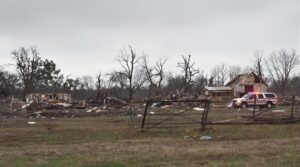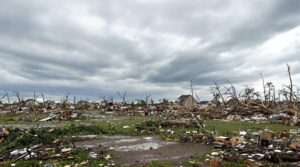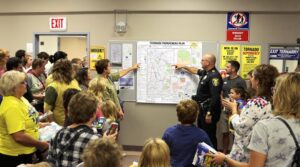EF2 tornadoes generate wind speeds of 111-135 mph (178-217 km/h) and comprise 8.41% of all recorded tornado events. These storms systematically remove roofs from well-constructed buildings, uproot large trees, and cause catastrophic damage to mobile homes, with 81% experiencing complete destruction. From 2007-2017, EF2 tornadoes caused 1,953 injuries and 113 fatalities in the U.S. Understanding proper safety protocols and damage patterns proves critical for survival during these significant meteorological events.
Key Takeaways
- EF2 tornadoes generate wind speeds between 111-135 mph and can systematically remove roofs from well-constructed buildings and uproot large trees.
- These tornadoes account for 8.41% of all recorded events and caused 1,953 injuries and 113 fatalities from 2007-2017.
- Mobile homes face extreme risk during EF2 tornadoes, with 81% experiencing complete destruction and residents needing pre-planned evacuation routes.
- Seek shelter immediately in basements or windowless interior rooms; never attempt to outrun the tornado or shelter under highway overpasses.
- Modern warning systems include mobile alerts, sirens, and weather radios to provide timely notifications for at-risk populations.
Understanding EF2 Tornado Classification
Tornadoes classified as EF2 on the Enhanced Fujita Scale represent a significant atmospheric phenomenon characterized by considerable destructive potential. As the third weakest designation on the scale, EF2 tornadoes account for 8.41% of all recorded tornado events, demonstrating their relative frequency in severe weather patterns.
With wind speeds 111-135 mph, EF2 tornadoes pose serious threats to communities in their path. The tornado classification criteria for EF2 designation encompasses specific damage indicators that meteorologists use to assess and categorize these storms. Between 2007 and 2017, the United States documented 1,157 confirmed EF2 tornadoes, providing substantial data for understanding EF2 tornado characteristics.
These storms typically manifest their intensity through distinctive damage patterns, including the removal of roofs from well-constructed buildings, uprooting of large trees, and overturning of boxcars.
The Enhanced Fujita Scale, which replaced its predecessor to provide more accurate wind speed estimates, enables meteorologists to precisely evaluate tornado intensity based on observable damage patterns and structural impacts.
Wind Speed and Intensity Measures
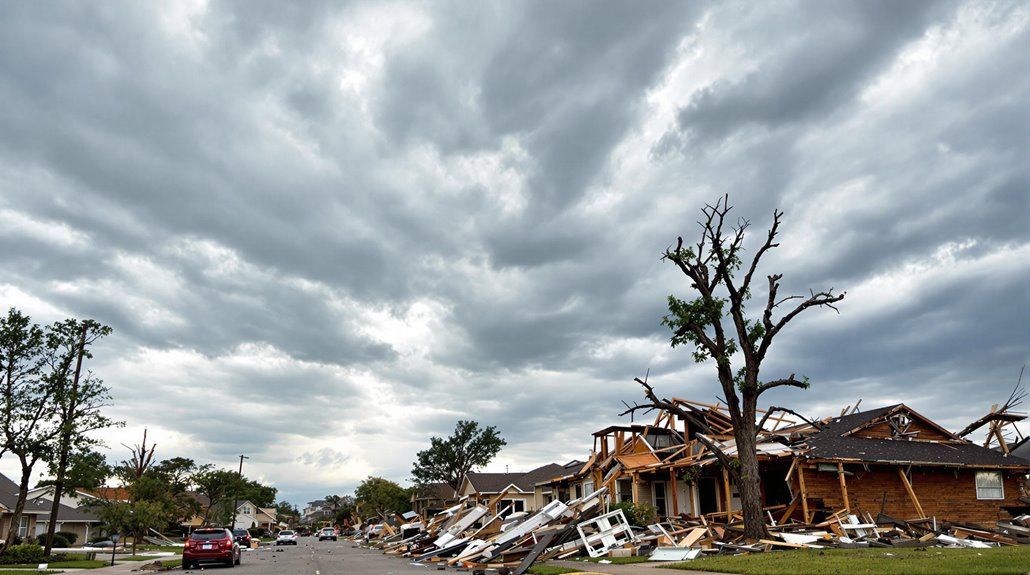
Wind speed measurements form the fundamental basis for categorizing tornado intensity on the Enhanced Fujita (EF) Scale, with EF2 tornadoes exhibiting three-second wind gusts between 111-135 mph (178-217 km/h).
Since direct measurement of tornado wind speeds remains challenging due to the rarity of tornadoes passing near meteorological instruments, intensity assessments primarily rely on damage surveys. Violent tornadoes comprise less than 1% of all recorded events.
The wind speed estimation process utilizes 28 specific damage indicators (DIs) and corresponding degrees of damage (DoD) to evaluate tornado intensity. For EF2 classification, surveyors analyze structural damage patterns, comparing observed destruction against standardized indicators.
While radar technology and photogrammetry provide supplementary data, the EF Scale primarily depends on post-event damage assessment. This methodology, though indirect, offers a standardized approach to tornado classification, integrating multiple factors including construction quality and regional variations in building practices to determine final intensity ratings.
Distinctive EF2 Damage Patterns
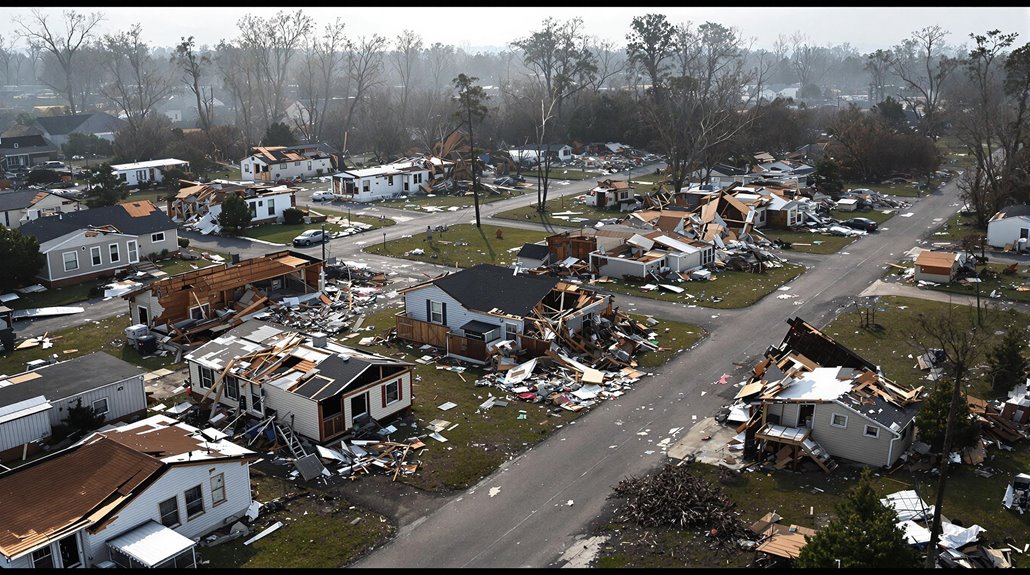
EF2 tornadoes exhibit distinct structural impact patterns characterized by the systematic removal of roofs from well-constructed houses and the complete collapse of exterior walls in poorly built structures.
Mobile homes sustain catastrophic damage at this intensity level, with complete destruction occurring in 81% of documented cases where full roof removal precedes structural failure.
The correlation between envelope breaches and internal pressure buildup creates a progressive damage sequence, leading to extensive structural compromise in both permanent and temporary housing units. With wind speeds of 111 to 135 mph, EF2 tornadoes can shift building foundations and create significant structural instability.
Structural Impact Assessment
Three distinct damage patterns characterize structural impacts from EF2-rated tornadoes, operating within the 113-157 mph wind speed range.
Primary structural integrity failures occur at roof-to-wall connections, where coverings and sheathing can be forcibly removed.
Secondary damage manifests through compromised building envelope components, including blown-out windows, collapsed doors, and stripped siding.
The third pattern involves displacement of substantial objects, where appliances and heavy furniture become mobilized.
Damage assessment protocols indicate that well-constructed frame houses typically experience severe roof damage and partial wall collapse.
The ETDA Tool confirms these patterns through field observations, showing consistent damage ratios relative to tornado centerline distance.
Critical vulnerabilities concentrate at connection points, particularly roof attachments and wall assemblies, where wind forces exceed design thresholds.
The cylindrical annulus pattern of strong tornadoes creates intense pressure differentials that significantly amplify structural damage potential.
Mobile Home Destruction Patterns
Mobile homes exhibit catastrophic structural failures during EF2 tornado events, with destruction patterns markedly distinct from conventional buildings.
Studies indicate that mobile home vulnerability is heightened by inadequate foundation anchoring, resulting in complete structural displacement up to 1,000 feet from original sites when subjected to EF2 wind speeds of 111-135 mph.
Statistical analysis demonstrates that mobile home residents face 10-20 times higher fatality risks compared to traditional housing occupants, with 53% of tornado-related home deaths occurring in these structures despite representing only 6% of U.S. housing units.
The destruction sequence typically initiates with foundation failure, followed by catastrophic structural separation and displacement. The risk is especially concerning as tornado patterns shift toward southern states where mobile homes are more dispersed.
These patterns underscore the critical importance of implementing enhanced tornado safety measures, including improved anchoring systems and immediate access to designated storm shelters.
Essential Safety Protocols
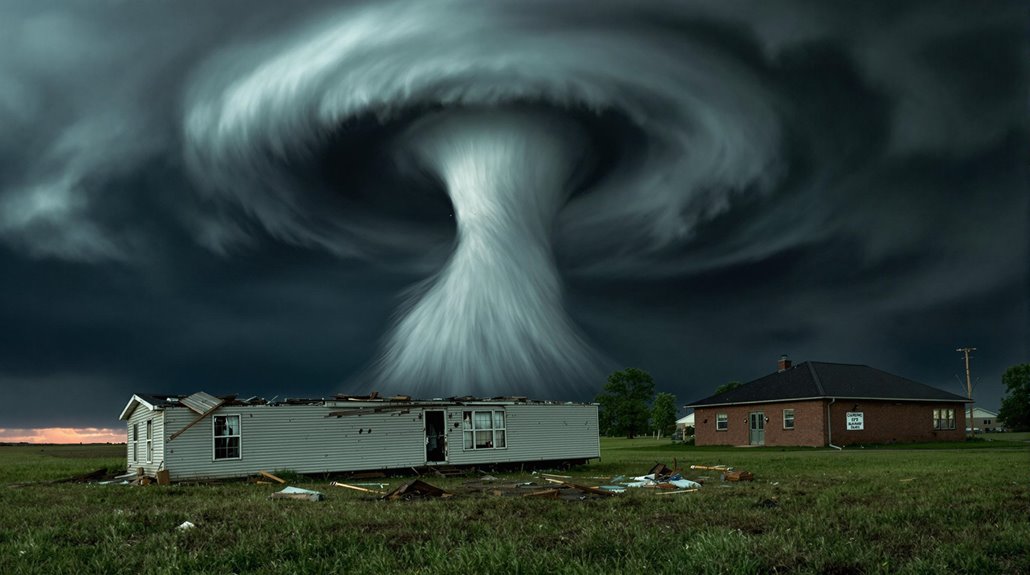
During EF2 tornado emergencies, individuals must immediately relocate to pre-identified safe rooms built to FEMA specifications or ICC 500 storm shelter standards, prioritizing windowless interior spaces on the lowest building level.
Mobile home residents face heightened risk during EF2 events and require advance evacuation plans to relocate to sturdy buildings or community shelters before tornado conditions develop.
Emergency preparedness requires establishing multiple shelter options and maintaining emergency communication systems to receive real-time tornado warnings and execution signals.
Shelter During Tornado Emergencies
When severe weather spawns an EF2 tornado, proper shelter selection becomes the critical determinant between life and death.
Tornado preparedness strategies emphasize seeking refuge in basements or the lowest level of sturdy buildings, specifically in interior, windowless rooms away from areas beneath heavy overhead objects. Emergency communication methods should include text messaging and physical signals rather than shouting.
In vehicles, occupants must avoid attempting to outrun the tornado and instead locate immediate shelter in robust structures.
If shelter is inaccessible, drivers should park safely, remain belted, and position themselves below window level. Under no circumstances should individuals seek protection beneath highway overpasses or bridges.
In public spaces, interior bathrooms, storage rooms, and enclosed areas provide ideal protection when combined with additional coverage from furniture or other sturdy materials.
Mobile Home Evacuation Tactics
Given the catastrophic vulnerability of manufactured housing to tornadic activity, immediate evacuation protocols represent the cornerstone of mobile home safety during severe weather events.
Statistical data indicates residents of mobile homes face 15-20 times higher fatality risks during tornadoes compared to conventional housing occupants, with 54% of tornado-related home fatalities occurring in mobile structures.
Effective evacuation planning requires implementation of multiple critical components: monitoring weather alerts, identifying pre-designated community shelters, establishing evacuation routes, and executing departures during tornado watches rather than warnings.
Research demonstrates that anchor system failures constitute the primary failure mode in mobile homes during tornadic events.
Consequently, evacuation to reinforced structures, particularly those with underground facilities, remains the sole viable safety strategy when EF-2 tornadoes threaten manufactured housing communities.
Mobile Home and Vehicle Protection
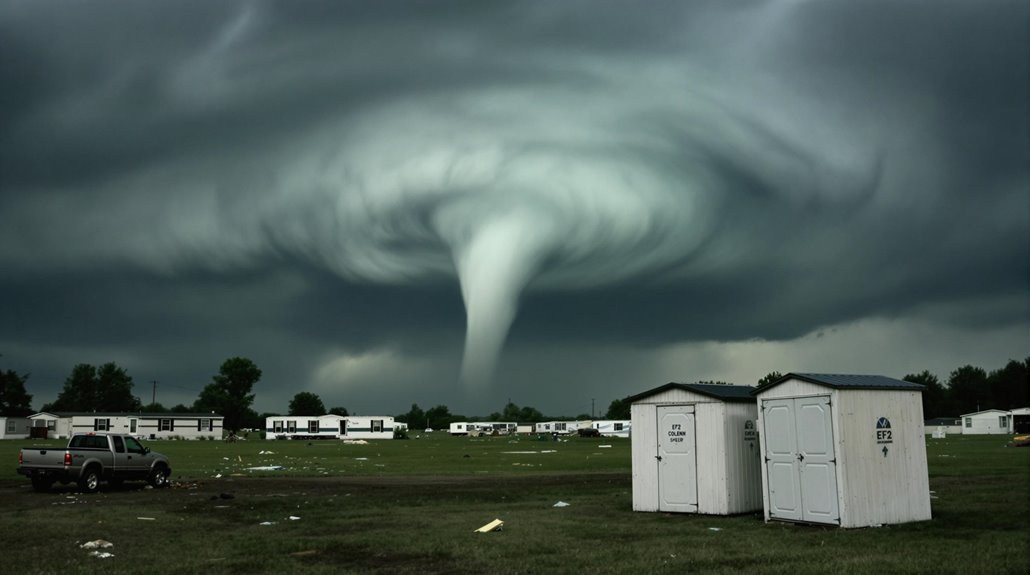
Two critical vulnerabilities in tornado situations are mobile homes and vehicles, both of which provide inadequate protection against EF2-level winds.
Mobile home safety statistics reveal residents face 15-20 times higher fatality risks compared to permanent structures, with anchoring system failures being the primary cause. These structures typically fail from the bottom up, becoming airborne during tornadic events, with even EF-1 tornadoes capable of complete destruction.
Vehicle evacuation protocols emphasize that attempting to outrun tornadoes is extremely dangerous. Instead, residents should:
- Identify pre-planned evacuation routes to sturdy buildings
- Locate accessible community storm shelters
- Establish arrangements with friends or family in permanent structures
- Monitor weather alerts for early evacuation opportunities
When severe weather threatens, immediate evacuation to site-built structures is essential for survival.
Gas stations and local community shelters can serve as temporary refuge when permanent buildings are inaccessible.
Historical Impact and Statistics
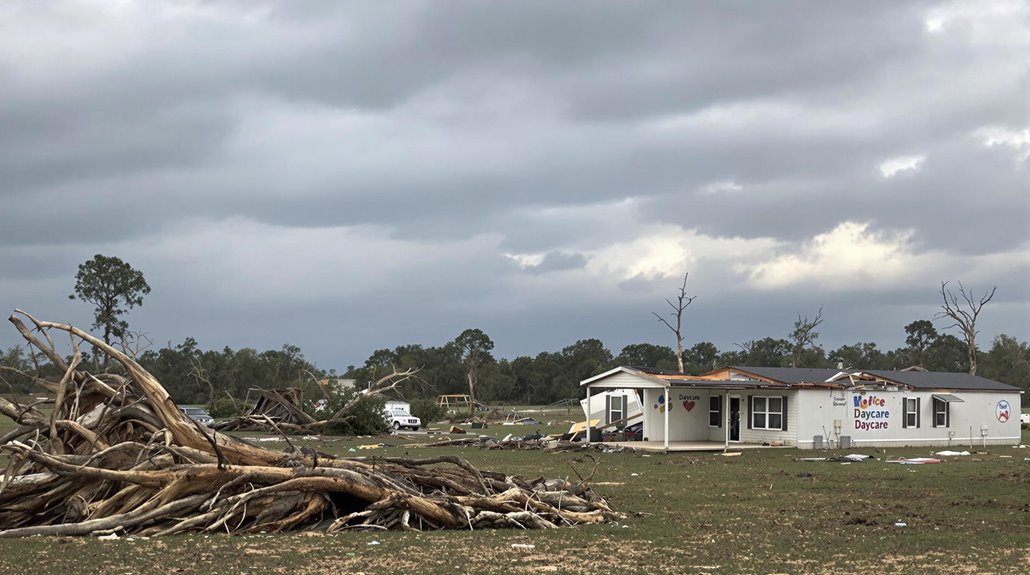
The documented history of EF2 tornadoes reveals both their destructive capacity and statistical prevalence in the United States. Statistical analysis from 2007 to 2017 recorded 1,953 injuries and 113 fatalities, with the deadliest incidents occurring in Georgia and Kentucky in 2017 and 2012 respectively, each resulting in six deaths.
Historical patterns demonstrate consistent economic impacts in affected regions. Counties struck by EF2 tornadoes typically experience reduced employment growth, though wage rates initially increase due to reconstruction demands. Rural areas particularly show sustained wage growth effects lasting up to two years post-event.
Notable incidents include the 2023 Selma tornado, which caused significant structural damage including a daycare facility's partial roof collapse, and a 2015 event that resulted in 119 injuries.
With wind speeds ranging from 111 to 135 mph, EF2 tornadoes consistently demonstrate the capacity to overturn mobile homes, uproot large trees, and generate dangerous airborne debris.
Debunking Common EF2 Misconceptions

Despite widespread beliefs about tornado behavior, numerous misconceptions surrounding EF2 tornadoes persist in public understanding. Several tornado myths require scientific correction, particularly regarding their formation, movement patterns, and safety protocols. Data collected between 2007-2017 demonstrates that EF2 tornadoes, with wind speeds of 111-135 mph, caused 113 fatalities and 1,953 injuries in the United States.
Common safety misconceptions can prove dangerous during tornadic events. Critical safety myths that require correction include:
- Opening windows to equalize pressure (unnecessary and wastes valuable shelter time)
- Seeking shelter under highway overpasses (extremely dangerous practice)
- Assuming tornadoes only occur in specific regions (they can form anywhere)
- Believing tornado size indicates strength (small tornadoes can be intense)
The presence of "suction vortices" explains why damage patterns may appear irregular, debunking the myth that tornadoes "skip" houses.
Understanding these scientific facts enables better preparedness and response during EF2 tornado events.
Weather Warning Systems and Preparation

Modern weather warning systems form a critical component of tornado preparedness, integrating multiple technological platforms to deliver timely, accurate alerts to at-risk populations. These systems employ sophisticated algorithms and real-time data analysis to enhance emergency communication effectiveness through multiple channels.
| Warning System Component | Implementation Strategy |
|---|---|
| Mobile Alerts | WEA integration, FEMA app deployment |
| Siren Networks | Strategic placement, automated triggers |
| Weather Radios | NOAA frequency monitoring, battery backup |
| Digital Platforms | Real-time storm tracking, custom notifications |
| Local Alert Systems | Community-specific protocols, rapid dissemination |
Tornado preparedness strategies emphasize a multi-layered approach to warning dissemination, combining traditional methods with advanced technology. Critical elements include geographically targeted alerts, redundant communication channels, and validated detection protocols. Communities implement these systems through coordinated emergency management programs, ensuring residents receive warnings through multiple pathways while maintaining system reliability and accuracy during severe weather events.
The Benefits Of Consulting A Public Adjuster
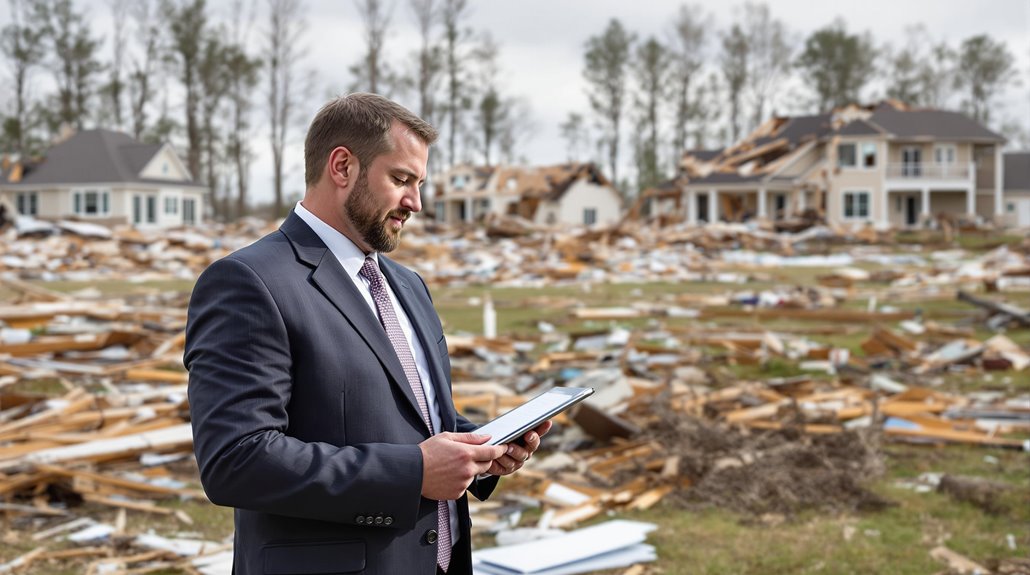
Following an EF2 tornado event, engaging a licensed public adjuster provides critical expertise in managing complex insurance claims processes and conducting objective damage assessments.
Public adjusters' professional knowledge of insurance policies and regulations enables a more streamlined claims process, reducing policyholder stress while ensuring thorough documentation of tornado damage.
Statistical data indicates that claims handled by public adjusters typically result in higher settlement amounts, with adjusters leveraging their expertise to identify and document all covered damages within the policy framework.
With fees typically ranging from 10-20% of the final settlement amount, public adjusters only receive compensation upon successfully resolving claims in the policyholder's favor.
Expertise In Insurance Claims
When maneuvering the complexities of tornado-related insurance claims, consulting a public adjuster offers significant advantages through their specialized expertise in policy interpretation and claims management.
These professionals possess extensive knowledge of insurance jargon and employ proven claim strategies to maximize settlements for policyholders affected by EF2 tornado damage.
Public adjusters streamline the claims process through:
- Detailed documentation of structural and property damage assessments
- Professional interpretation of policy coverage and exclusions
- Strategic preparation and submission of proof of loss documents
- Expert negotiation with insurance carriers to optimize settlement outcomes
Their expertise extends beyond basic claim filing, encompassing regulatory compliance, damage valuation, and tactical communication with insurers.
Statistical evidence demonstrates that professionally managed claims typically result in higher settlement amounts compared to self-managed claims.
Operating on a contingency fee basis, public adjusters typically charge 5-20% of the final settlement amount, making their services accessible to most policyholders.
Objective Damage Assessment
Professional damage assessment by public adjusters provides a methodical, unbiased evaluation of tornado-related destruction that surpasses standard insurance company inspections. Their expertise enables extensive damage evaluation through detailed documentation, including multi-angle photography and systematic property inspection protocols.
Public adjusters employ specialized knowledge to identify both visible and concealed structural damage that might otherwise go unnoticed. Their thorough insurance documentation process incorporates professional evaluations, repair estimates, and systematic recording of all communications.
This methodical approach proves invaluable when addressing claim denials or disputes over coverage extent.
Statistical evidence demonstrates that public adjuster involvement typically results in higher settlement amounts due to their ability to detect hidden damages and negotiate effectively with insurance carriers, ensuring policyholders receive appropriate compensation for their losses.
While insurance adjusters focus on minimizing company costs, public adjusters serve as dedicated advocates ensuring maximum settlement amounts for tornado victims.
Streamlined Claim Process
A significant advantage of engaging public adjusters lies in their ability to streamline the insurance claim process through systematic documentation and expedited settlements.
Their expertise in policy interpretation and claim efficiency enables thorough management of all aspects, from initial filing to final resolution.
Key elements of documentation management that public adjusters implement include:
- Systematic organization of damage evidence and supporting materials
- Detailed inventory compilation of affected property
- Professional documentation of structural and content losses
- Chronological tracking of all claim-related communications
Public adjusters serve as intermediaries between policyholders and insurance companies, facilitating effective communication while ensuring compliance with policy requirements.
Their professional expertise in negotiation and thorough understanding of claim procedures helps prevent common issues such as underpayment or denial, ultimately maximizing the potential for fair settlements.
The industry maintains strict code of conduct standards requiring clear communication and timely updates throughout the entire claims process.
Higher Claim Payouts & Settlements
Statistical evidence demonstrates that engaging public adjusters markedly increases insurance claim settlements for tornado damage, with studies indicating an average payout difference of $3,607 higher compared to self-managed claims.
Public adjusters achieve these enhanced settlements through thorough damage evaluation protocols and expert claim negotiation strategies. Their methodical assessment process identifies both obvious and latent damage patterns, ensuring detailed documentation of all legitimate claims.
These professionals leverage their extensive knowledge of insurance policies and industry procedures to counter common dispute tactics, including allegations of pre-existing damage or misclassified tornado intensity.
Operating on a contingency fee basis, public adjusters provide their expertise without upfront costs, while simultaneously reducing the policyholder's administrative burden and emotional stress throughout the claims process.
With fees typically ranging 5% to 15% of the final settlement, public adjusters often justify their cost through significantly higher payouts and comprehensive claim management.
About The Public Claims Adjusters Network (PCAN)
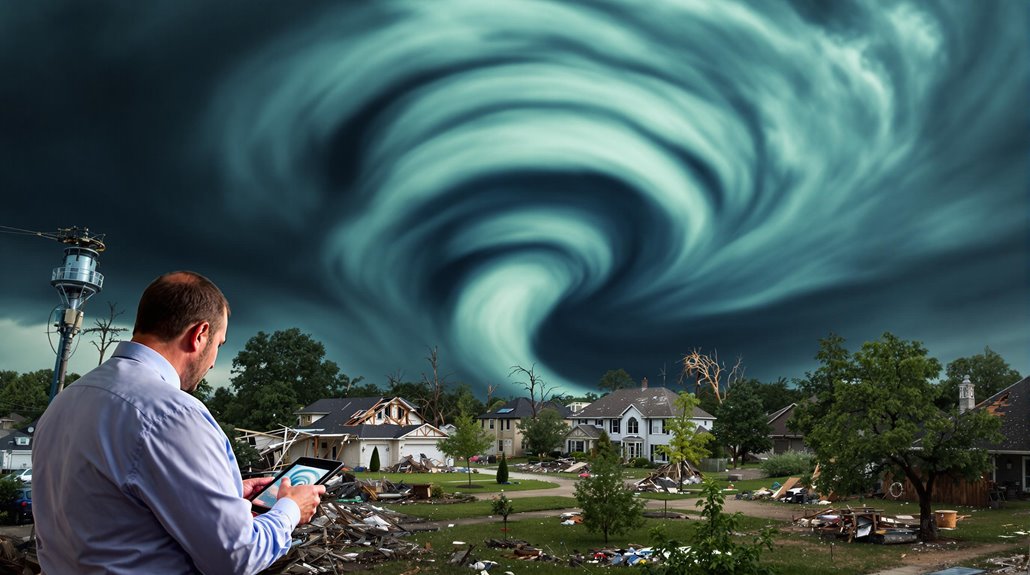
Licensed public insurance adjusters within the Public Claims Adjusters Network (PCAN) form an interconnected system of professionals who specialize in representing policyholders during insurance claim processes.
These state-licensed experts execute essential public adjuster roles, including thorough claim documentation, damage assessment, and negotiation with insurance carriers to secure ideal settlements.
PCAN members demonstrate expertise through:
- Proven track records of securing 300-400% higher claim settlements
- Specialized knowledge in residential and commercial property claims
- State-specific licensing and regulatory compliance
- Advanced training in policy interpretation and damage evaluation
The network operates on a contingency fee basis, eliminating upfront costs for policyholders while providing access to emergency services and mitigation support.
PCAN's international presence enables coordinated responses across multiple jurisdictions, particularly beneficial for large-scale disasters like EF2 tornadoes, where thorough property damage assessment and documentation are critical for maximum claim recovery.
Frequently Asked Questions
How Long Does an Average EF2 Tornado Stay on the Ground?
Churning through the landscape like a relentless force, the average tornado lifespan of an EF2 extends beyond 20 minutes, with a typical tornado duration allowing it to traverse over 7 miles of terrain.
Can EF2 Tornadoes Occur at Night or During Winter Months?
EF2 tornadoes can occur during both nighttime hours and winter months. Tornado occurrence patterns indicate year-round potential, though seasonal patterns show reduced frequency during winter compared to peak spring-summer months.
What Percentage of Annual Tornadoes in the US Are EF2?
According to tornado frequency statistics, EF2 tornadoes comprise 14% of annual tornadoes in the United States, representing a significant segment of documented events capable of producing considerable structural damage.
Do EF2 Tornadoes Produce Distinctive Sounds Different From Other Tornado Categories?
While infrasound measurements detect frequencies between 0.5-3 Hz in all tornadoes, research has not conclusively demonstrated that EF2 tornadoes produce distinctive sounds separate from other tornado categories' characteristic patterns.
How Far in Advance Can Meteorologists Typically Predict an EF2 Tornado?
Modern weather technology enables tornado prediction 1-7 hours before formation, though specific EF2 intensity forecasting remains challenging. Real-time warnings typically provide 13-15 minutes of advanced notice.
References
- https://www.factsjustforkids.com/weather-facts/ef2-tornado/
- https://www.iccsafe.org/building-safety-journal/bsj-dives/how-damage-determines-a-tornados-rating-from-fujita-to-enhanced-fujita/
- http://www.meteor.iastate.edu/~ssanteiu/PDFs/314portfolio.pdf
- https://www.e-education.psu.edu/meteo3/l9_p8.html
- https://rainbowrestores.com/blog/what-is-the-fujita-scale
- https://en.wikipedia.org/wiki/EF4
- https://www.britannica.com/science/tornado/Tornado-intensity
- https://www.weather.gov/oun/efscale
- https://www.torro.org.uk/research/tornadoes/tscale
- https://www.phrc.psu.edu/assets/docs/Publications/2013RBDCCPapers/Roueche-2013-RBDCC-Tornado.pdf
